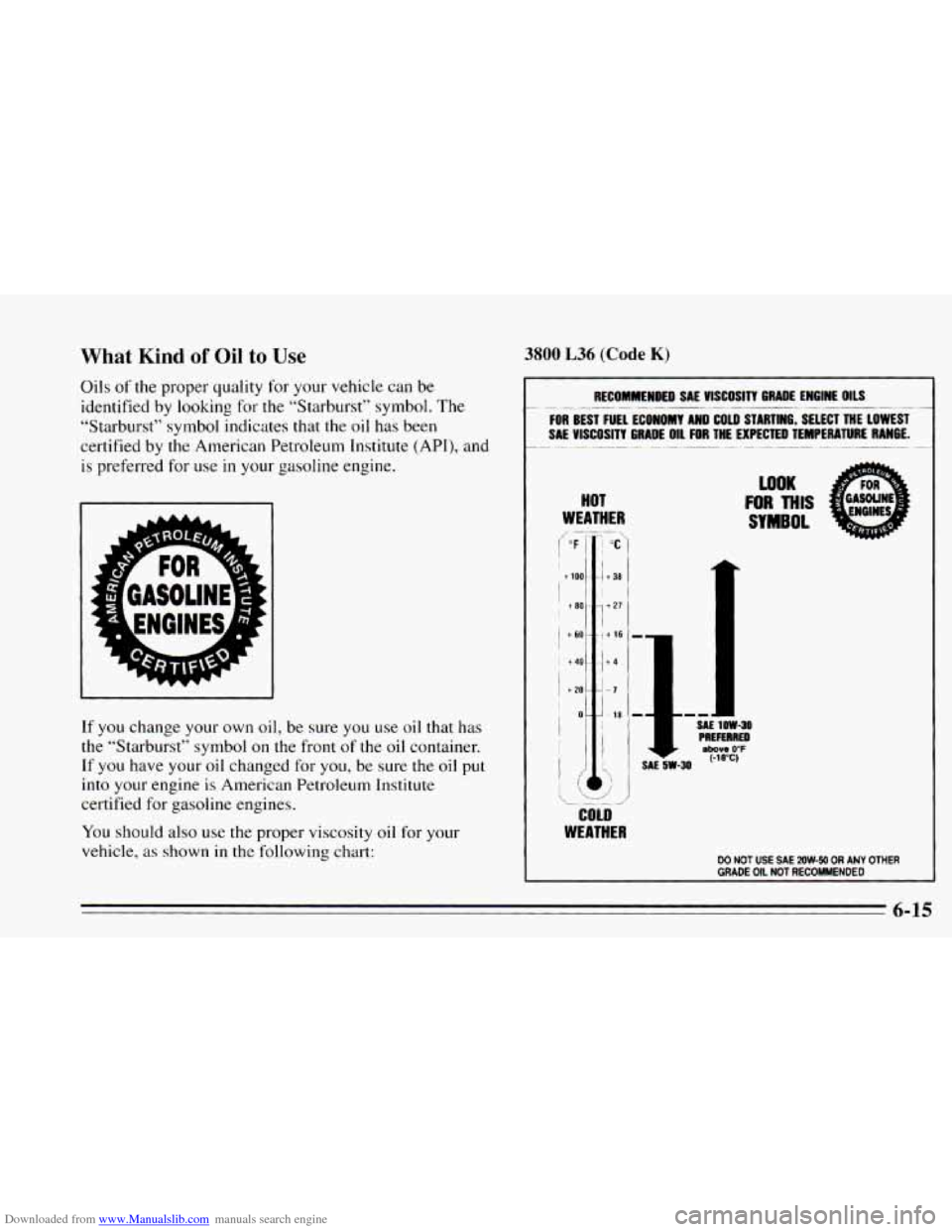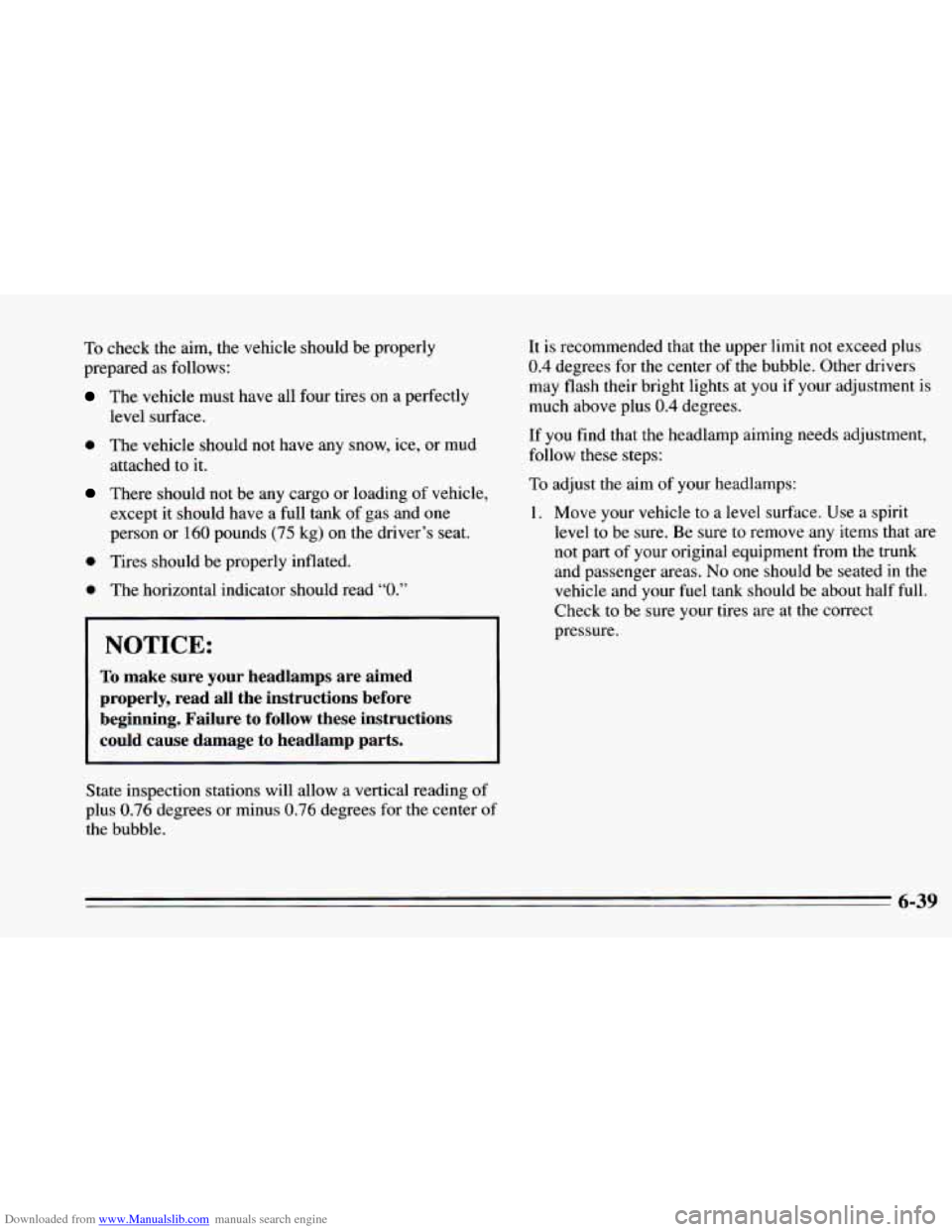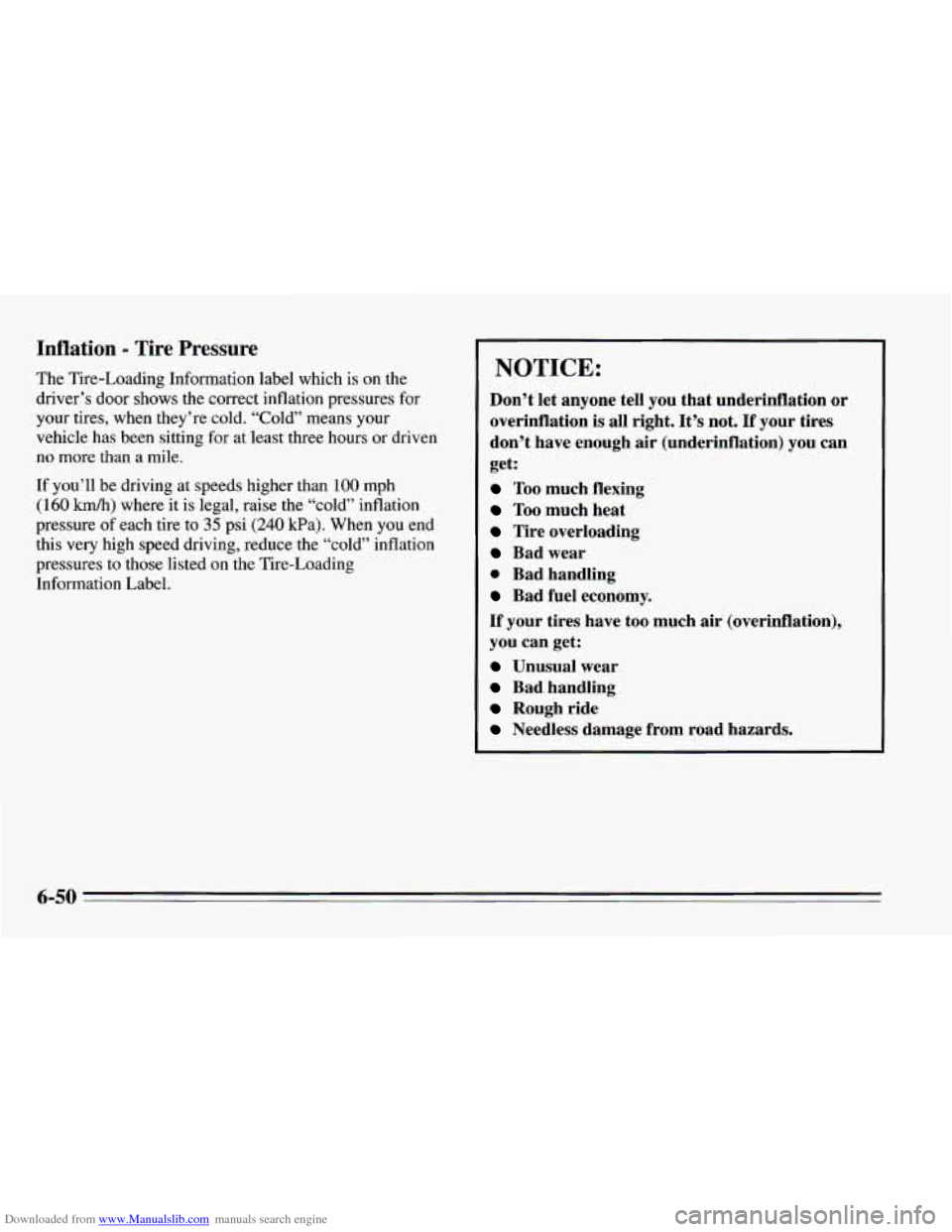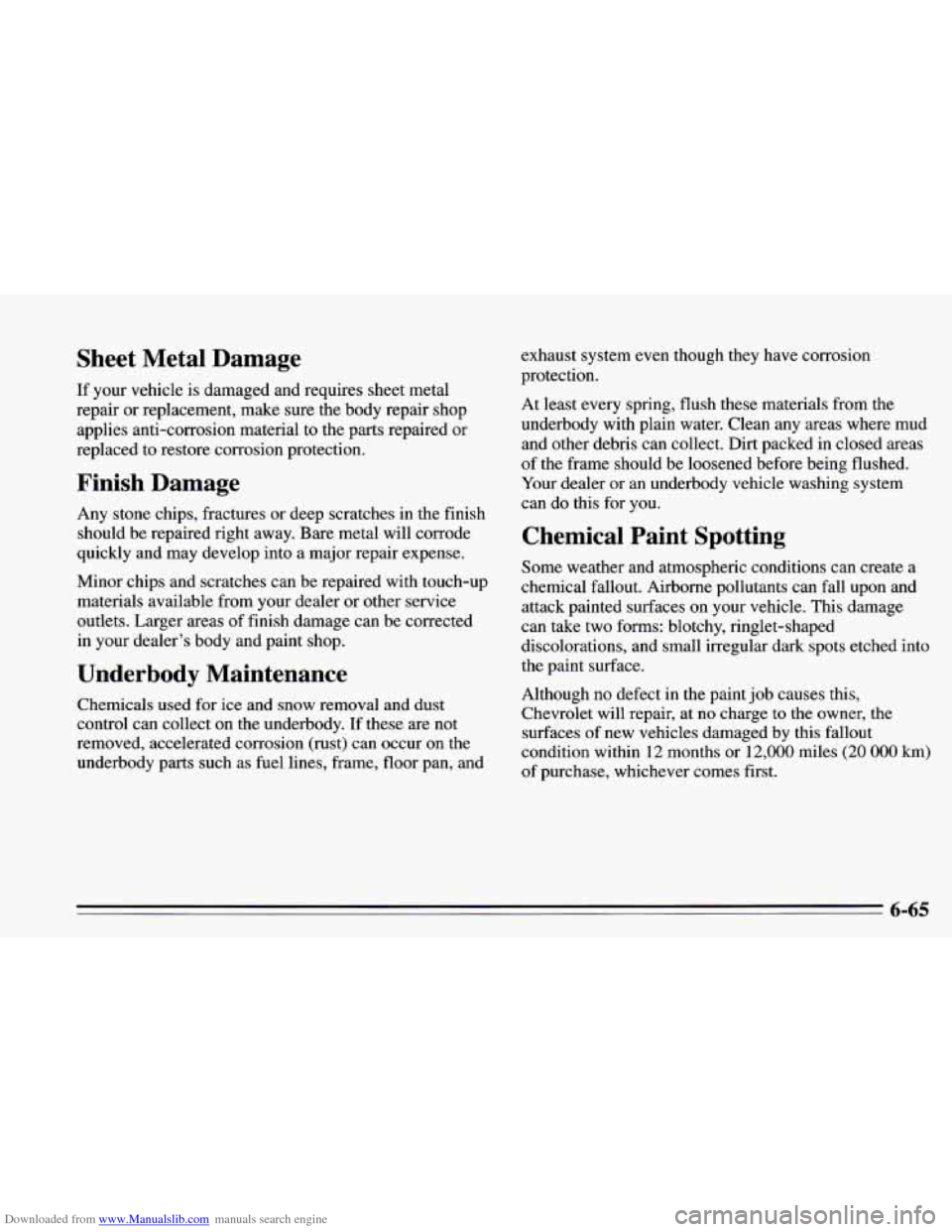1995 CHEVROLET CAMARO fuel
[x] Cancel search: fuelPage 247 of 388

Downloaded from www.Manualslib.com manuals search engine What Kind of Oil to Use 3800 L36 (Code K)
Oils of the proper quality for your vehicle can be
identified by looking for the “Starburst” symbol. The
“Starburst” symbol indicates that the oil
has been
certified by the American Petroleum Institute
(API), and
is preferred for use in your gasoline enpine.
If you change your
own oil, be sure you use oil that has
the “Starburst” symbol
on the front of the oil container.
If you have your oil changed for you, be sure the oil put
into your engine is American Petroleum institute
certified for gasoline engines.
You should also use the proper viscosity oil for your
vehicle, as shown in the following chart:
RECOMMENDED SAE VlSCOSlW GRADE ENGINE OILS
FOR BEST FUEL EONOMY AND COLD STARTING, SELECT THE LOWEST
SA€ VISCOSITY GRADE OIL
FOR THE EXPECTED TEMPERATURE RANGE.
__-_____ -
-- -_.___--____--I__--
WOK
FOR THIS
SYMBOL
I SAE 5W-30
COLD
WEATHER
DO NOT USE SAE 20W-50 OR ANY OTHER GRADE OIL NOT RECOMMENDED
6-15
Page 248 of 388

Downloaded from www.Manualslib.com manuals search engine 3.4L L32 (Code S) and 5.7L LTl (Code P)
RECOMMENDED SAL VISCOSITY GRADE EN61NE OILS
FOR BEST FUEL ECONOMY AND COLD STARTING, SELECT THE LOWEST
SAL VISCOSITY GRADE OIL FOR THE EXPECTED TEMPERATURE RANGE.
-~ .______ __ ~___ ~~ .
_.__ ~ ~ .~ __ .
HOT
WEATHER
I I
i I
’ - 18
i I
WEATHER
SAE ZW-30 PREFERRED
00 NOT USE SAE 2OW-50 OR ANY OTHER
GRADE OIL NOT RECOMMENDED
As shown in the chart, SAE 5W-30 is best for your
vehicle. However, you can use
SAE 1OW-30 if it’s going
to be 0°F (-18°C) or above. These numbers on an oil
container show its viscosity, or thickness. Do not use
other viscosity oils, such
as SAE 20W-50.
As shown in the chart, SAE low-30 is best for your
3.8L equipped vehicle. However, you can use SAE
5W-30 if it’s going to be colder than 60°F (16°C)
before your next oil change. When it’s very cold, you
should use
SAE 5W-30. These numbers on an oil
container show its viscosity, or thickness. Do not use
other viscosity
oils, such as SAE 20W-50.
I NOTICE:
Use only engine oil with the American Petroleum
Institute Certified For Gasoline Engines
“Starburst” symbol. Failure to use the proper oil
can result in engine damage not covered by your warranty.
GM Goodwrench@ oil (in Canada, GM Engine Oil)
meets
all the requirements for your vehicle.
6-16
Page 271 of 388

Downloaded from www.Manualslib.com manuals search engine To check the aim, the vehicle should be properly
prepared as follows:
The vehicle must have all four tires on a perfectly
level surface.
0 The vehicle should not have any snow, ice, or mud
There should not be any cargo or loading of vehicle,
except it should have a full tank of gas and one
person or
160 pounds (75 kg) on the driver’s seat.
attached to
it.
0 Tires
should be properly inflated.
0 The horizontal indicator should read “0.”
I NOTICE:
To make sure your headlamps are aimed
properly, read all the instructions before
beginning. Failure to
follow these instructions
could cause damage to headlamp parts.
State inspection stations will allow a vertical reading of
plus
0.76 degrees or minus 0.76 degrees for the center of
the bubble. It
is recommended that the upper limit not exceed plus
0.4 degrees for the center of the bubble. Other drivers
may flash their bright lights at you if your adjustment is
much above plus
0.4 degrees.
If you find that the headlamp aiming needs adjustment,
follow these steps:
To adjust the aim of your headlamps:
1. Move your vehicle to a level surface. Use a spirit
level to be sure. Be sure to remove any items that are
not part of your original equipment from the trunk
and passenger areas.
No one should be seated in the
vehicle and your fuel tank should be about half full.
Check to be sure your tires are at the correct
pressure.
6-39
Page 282 of 388

Downloaded from www.Manualslib.com manuals search engine Inflation - Tire Pressure
The Tire-Loading Information label which is on the
driver’s door shows the correct inflation pressures for
your tires, when they’re cold. “Cold” means your
vehicle has been sitting for at least three hours or driven
no
more than a mile.
If you’ll be driving at speeds higher than 100 mph
(160 kmk) where it is legal, raise the “cold” inflation
pressure of each tire to
35 psi (240 kPa). When you end
this very high speed driving, reduce the “cold” inflation
pressures to those listed on the Tire-Loading
Information Label.
NOTICE:
Don’t let anyone tell you that underinflation or
overinflation is all right. It’s not. If your tires
don’t have enough air (underinflation) you can
get:
Too much flexing
Too much heat
Tire overloading
Bad wear
0 Bad handling
Bad fuel economy.
If your tires have too much air (overinflation),
you can get:
Unusual wear
Bad handling
Rough ride
Needless damage from road hazards.
6-50
Page 297 of 388

Downloaded from www.Manualslib.com manuals search engine Sheet Metal Damage
If your vehicle is damaged and requires sheet metal
repair or replacement, make sure the body repair shop
applies anti-corrosion material to the parts repaired or
replaced to restore corrosion protection.
Finish Damage
Any stone chips, fractures or deep scratches in the finish
should be repaired right away. Bare metal will corrode
quickly and may develop into a major repair expense.
Minor chips and scratches can be repaired with touch-up
materials available from your dealer or other service
outlets. Larger areas of finish damage can be corrected
in your dealer’s body and paint shop.
Underbody Maintenance
Chemicals used for ice and snow removal and dust
control can collect on the underbody.
If these are not
removed, accelerated corrosion (rust) can occur on the
underbody parts such as fuel lines, frame, floor pan, and exhaust
system even though they have corrosion
protection.
At least every spring, flush these materials from the
underbody with plain water. Clean any areas where mud
and other debris can collect. Dirt packed in closed areas
of the frame should be loosened before being flushed.
Your dealer or an underbody vehicle washing system
can do this for you.
Chemical Paint Spotting
Some weather and atmospheric conditions can create a
chemical fallout. Airborne pollutants can fall upon and
attack painted surfaces on your vehicle. This damage
can take two forms: blotchy, ringlet-shaped
discolorations, and small irregular dark spots etched into
the paint surface.
Although no defect in the paint job causes this,
Chevrolet
will repair, at no charge to the owner, the
surfaces of new vehicles damaged by this fallout
condition within 12 months or 12,000 miles
(20 000 km)
of purchase, whichever comes first.
6-65
Page 303 of 388

Downloaded from www.Manualslib.com manuals search engine 1. ABS BAT Electronic Brake Control Module
2. FOG LTS: Fog Lamps
3. Not Used
4. Not Used
5. ABS IGN: Anti-Lock Brake System
6. FAN/ACTR: Coolant Fan Relays; EVAP Canister
Purge Solenoid; Exhaust Gas Recirculation; Low
Coolant Re1ay;Reverse Lockout Solenoid
7. AIR PUMP: Air Injection Pump Assembly; Air
8. PCM: Power Train Control Module
Pump
Relay
9. INJECTOR: Fuel Injectors
10. INJECTOR: Fuel Injectors
11. IGNITION: VIN Engine Code S: Camshaft Position
Sensor;Crankshaft Position Sensor; Electronic
Ignition Module VIN Engine Code P: Ignition Coil; Ignition Coil Driver
Cruise Control Switches and Module
12. A/C-CRUISE: Air Conditioning Compressor Relay;
Relays
B --Air Conditioning Compressor
C --Anti-Lock Brake System
D --Primary Coolant Fan (Driver Side)
E--Air Pump
F --Secondary Coolant Fan (Passenger Side)
G--ASR
H--Fog Lamps
J--Not Used
6-71
Page 304 of 388

Downloaded from www.Manualslib.com manuals search engine Main Fuse Block
FUSE USAGECHART I I
I ”- RADIO
€I 160 ACCY CRANK
WINDOWS BATT WIPER/WASH IP DIMMER IGN
12[--1 11- gn
80 70 60 50
DEFOG/SEATS CIGAR/HORN TAIL LTS GAGES
COURTESY PWR
ACCY STOPIHAZARD PCM ION
RADIO ACCY TURN B- U AIR BAG
SEE OWNER’S MANUAL FOR MORE INFORMATION
PRINTED IN U.S.A 10264034
1. AIR BAG: SIR Components
2. TURN B-U: Backup Lamp; Daytime Running
Lamps Module (Canada); Turn Flasher
3. HVAC: Heater Control Selector Switch (Heater/Air
Conditioner); Rear Defogger
4. RADIO ASSY: BOSE’ Relay
5. PCM IGN: Powertrain Control Module; PASS-Key
II@Decoder Module; Fuel Pump Relay
6.
7.
8.
9.
STOPEIAZARD: Brake Lamp/Cruise Release
Switch; Hazard Flasher
PWR ACCY Power Door Locks; Power Mirrors;
Hatch Release
COURTESY: Audio Alarm Module; Courtesy
Lamps: Console Compartment, Glove
Box, Dome,
Trunk, Rear Courtesy, Rearview Mirror and Radio
GAGES: Audio Alarm Module; Daytime Running
lamps Module (Canada); Diagnostic Energy Reserve
Module; Instrument Cluster; Remote Lock Control
Module
10. TAIL LTS: Exterior Lighting
11. CIGAWORN: Cigarette Lighter; Horn Relay
12. DEFOG/SEATS: Power Seats; Rear Defogger
13. IP DIMMER: Brightness Control
14. WIPEIUWASH: Windshield WiperNasher
15. WINDOWS: Power Windows, Convertible Top
(Circuit Breaker)
Switch (Circuit Breaker)
16. CRANK: Diagnostic Energy Reserve Module
17. RADIO: Radio Amplifier
Page 306 of 388

Downloaded from www.Manualslib.com manuals search engine Capacities and Specifications
Engine
Type VIN Engine Code
S and K ................... V6
VIN Engine Code
P ........................ V8
Fuel Delivery
...................... Fuel Injection
Valve Arrangement
...................... In-Head
Piston Displacement
VIN Engine Code
S .............. 207 CID (3.4L)
VIN Engine Code
K .............. 23 1 CID (3.8L)
VIN Engine Code
P .............. 350 CID (5.7L)
VIN Engine Code
S and K ................. 9.0: I
VIN Engine Code P ..................... 10.5: 1
VIN Engine Code S and K ........... 1-6-5-4-3-2
VIN Engine Code
P ............ 1-8-4-3-6-5-7-2
Compression Ratio
Firing Order
Wheel Nuts
Wheel Nut Torque ... 100
Ib. ft. (I 40 N-m)
Capacities (Approximate)
The following approximate capacities are given in U.S.
and metric conversions.
Air Conditioning?
..... See the refrigerant information
label under the hood.
Automatic Transmission
Drain and Refill
.................. IO pt. (4.7 L)*
VIN Engine Code S and K . . , . . , . . 17.6 pt. (8.3 L)*
VIN Engine Code P ............ 2 1.6 pt. (1 0.2 L)*
VIN Engine Code S
Overhaul
Cooling System
With Manual Transmission
...... 12.5 qt. (1 1.8 L)
With Automatic Transmission
, . . , 12.3 qt. (1 1.6 L)
With Manual Transmission
...... 12.5 qt. (1 1.8 L)
With Automatic Transmission .... 12.3 qt. (1 I .6 L)
With Manual Transmission ...... 15.3 qt. (14.5 L)
With Automatic Transmission
.... 15.1 qt. (14.3 L)
VIN
Engine Code
K
VIN Engine Code P
6-74